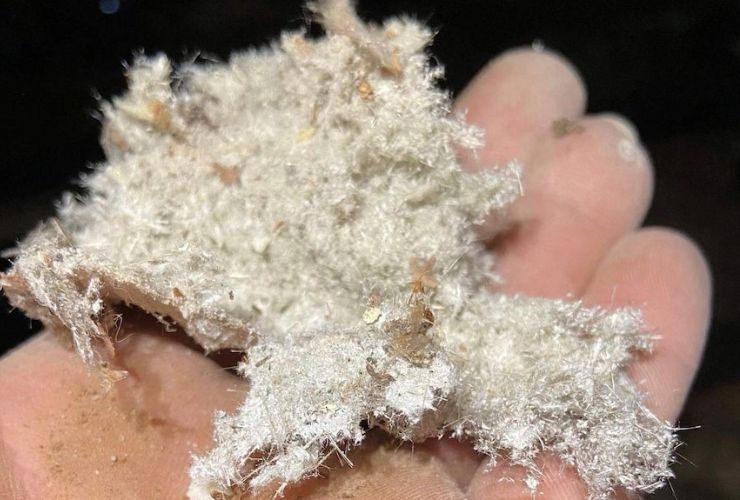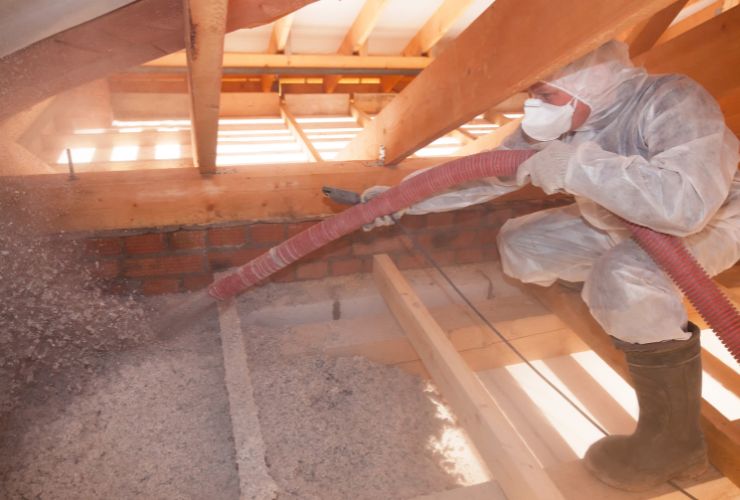
Fast read
Asbestos was widely used in the 1950s and 1960s because it was cheap, easy to use, effective, and simple to install.
But breathing in the small fibres can cause mesothelioma, a serious type of lung cancer. It was frequently employed in concentrations between 15% and 100% in roof insulation.
Thermal insulation made of asbestos typically comes in four different forms: loose-fill, wrap, block, and spray-on. To avoid disturbing any suspected poisonous roof insulation, seeing a specialist is crucial.
How can I tell if asbestos is in my insulation?
During the height of its popularity in the 1950s and ’60s, numerous brands employed asbestos in insulation. It was cheap, had great qualities, and was easy to install on the roofs of new homes.
The small fibres caused harm to the installers. They inhaled the fibres. This caused them to develop a severe lung cancer called mesothelioma. During the 1950s and 60s, the infamous Mr Fluffy disaster in Canberra saw the company pump loose-fill asbestos into hundreds of roof cavities making these homes highly dangerous timebombs for their occupants.
Up to 30,000 people were estimated to be affected by asbestos-related diseases, and around 700 workers died. The homes were later acquired by the ACT government and demolished.

It was commonly found in older roofing jobs in concentrations ranging from 15% to 100%. Loose-fill, pipe wrap, and spray-on insulation were all used by the building industry and remained in many buildings up to this day.
Asbestos insulation
This was the most common cause of asbestos exposure in the twentieth century. Many houses and businesses are still vulnerable to it today. The main reason it was used is that asbestos insulation was commonly thought to be a good material before its cancer-causing qualities became clear.
It is a naturally occurring mineral with a fibrous texture that resembles cotton. Because of the huge gap between its threads, the material is particularly heat resistant. Manufacturers can readily peel apart asbestos fibres, allowing them to be mixed with other materials, such as magnesia, to create various forms of insulation. It was so widely used that installers were known as asbestos workers for most of the twentieth century since they dealt with the substance so frequently.
It has been recognised that home renovators who unwittingly disturb asbestos-containing material such as fibro are at a high risk of developing lung cancer in subsequent years. For this reason, such danger must be recognised and avoided.

The four types
Four primary types of insulation that contain asbestos exist; Loose-fill, wrap, block and spray-on.
1. Block insulation
A slab of insulation can be bonded to the wall. In the past, these boards or blocks were nearly exclusively constructed of asbestos.
When such blocks are broken or sawed, this poses an exposure risk. Asbestos wall insulation was another name for this product. If you discover such a product in your home, do not disturb it and call in an expert to clearly identify the substance.
2. Spray-on
Spray-on also known as spray-foam insulation was created to make adding fireproofing materials to ceilings and walls more convenient. Large commercial structures frequently use spray-on techniques.
Asbestos can be found in up to 85% of spray-on insulating materials. This puts the employees who work on such ceilings and walls in grave danger.
Furthermore, if walls and ceilings are demolished or sanded, this activity will release poisonous particles into the environment. Therefore spray-on insulation can be a serious exposure hazard if not contained.
3. Loose-fill insulation
Attic floors, hollow areas in wall cavities, and other structures have all been treated in past decades with loose fill. Asbestos insulation is frequently built up almost entirely of loose fill and can be very dangerous. Even a slight breeze can make it unstable, allowing the particles to enter the air and your lungs.
Asbestos attic insulation is another name for this product. If you find it in the cavity of your home or business, stop disturbing this material at once and seek professional advice immediately.
4. Insulation wrappings:
In older buildings, asbestos was widely used to coat water pipes, ducts, and other HVAC components. Asbestos pipe insulation was a severe health danger aboard Navy ships for decades.
Pipes were encased in asbestos-based insulation before 1980. This is a form of asbestos-based paper cardboard. When this is damaged or removed, it begins to disintegrate and emits enormous amounts of asbestos dust.
So if you find insulation material of the four kinds, as seen above, in homes that were built before 1980, we recommend that you assume it could be bad for you. Please consult an expert before disturbing the material and putting you and your family in danger.


